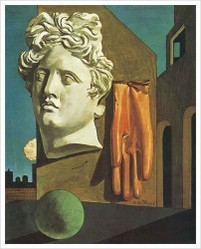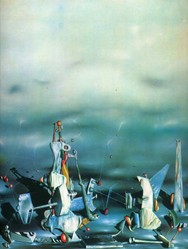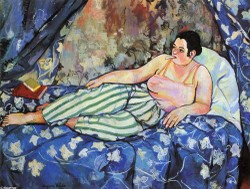Giorgio de Chirico was born in Volvos, Greece in 1888 to a Genovese mother and a Sicilian father. He first studied art at the Polytechnic School in Athens, but then moved to Germany in 1906 where he attended the Academy of Fine Arts in Munich.
Upon moving to Italy several years later, he would paint his first "Metaphysical Town Square" painting in 1910, "The Enigma of an Autumn Afternoon." These so-called "metaphysical" paintings, which he would produce largely up through 1919, are generally considered his most notable and influential works. Their haunting, eerie landscapes of buildings, empty squares, ominous shadows and strange mannequins would be highly regarded and revered by the developing surrealist art movement. Indeed, surrealist painter Yves Tanguy would state that it was seeing a de Chirico painting in a gallery window, in 1922, which so compelled him to pick up a paintbrush and become an artist himself.
However, by the autumn of 1919 de Chirico was becoming disillusioned with modern art and wanted to urge the artistic world to return to the ideas and methods of classical masters such as Raphael. His style began to change, even as he continued many of the themes and iconography from his earlier works - and these changes were not embraced by the many who had previously praised and admired his work. In 1939 he began to paint in a nearly exclusively Baroque style influenced by the work of Rubens, and resented that these works (which he considered superior to his earlier ones) were not accepted with the critical praise he had received in the past. Nevertheless, he remained a prolific painter until near his death in November 1978, at 90 years of age.
Giorgio de Chirico was married twice in his life - first to the Russian Ballerina Raissa Gurievich in 1924, and then to Isabella Pakszwer Far whom he met in 1930 and spent the rest of his life with, primarily in Rome, Italy.
For more biographical information on Giorgio de Chirico:
* Giorgio de Chirico - Wikipedia
* Fondazione Giorgio e Isa de Chirico












 A Potentially Fatal Accident in the Homeon 11/24/2018
A Potentially Fatal Accident in the Homeon 11/24/2018
 Windsurfing Lessons on Montserrat: One of My Funniest—and Fondest—Travel Memorieson 11/20/2018
Windsurfing Lessons on Montserrat: One of My Funniest—and Fondest—Travel Memorieson 11/20/2018
 Christmas Ornaments Celebrating Rome, Italyon 11/12/2018
Christmas Ornaments Celebrating Rome, Italyon 11/12/2018
 Philadelphia-Themed Christmas Ornamentson 11/09/2018
Philadelphia-Themed Christmas Ornamentson 11/09/2018



Comments
I didn't know about this Rome museum. Rome has so much to offer that I've been daunted from visiting so far. I know, it doesn't seem to make sense, but I kept telling myself that I'll visit after I learn more . . . and more . . . about it.